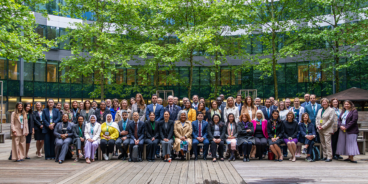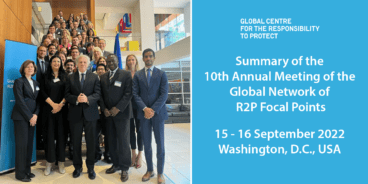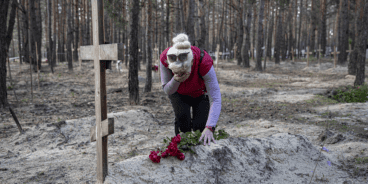Summary of the Eighth Annual Meeting of the Global Network of R2P Focal Points Helsinki, Finland, 2018
The governments of Finland and Mexico, in collaboration with the Global Centre for the Responsibility to Protect, co-hosted the eighth annual meeting of the Global Network of Responsibility to Protect (R2P) Focal Points in Helsinki, Finland, from 12 to 14 June. The meeting brought together senior government officials from 39 countries as well as representatives from the European Union, United Nations and civil society organizations.
The eighth annual meeting was opened by the Under- Secretary of State of Finland, Ms. Elina Kalkku, whoacknowledged Finland’s own history of conflict, noting that 2018 marks a century since the country’s civil war,and emphasized the importance of building trust for creating stability. During the opening ceremony, Ms. Kalkku was joined by the Legal Advisor of the Ministry of Foreign Affairs of Mexico, Mr. Alejandro Alday; the Special Adviser to the UN Secretary-General on the Prevention of Genocide, Mr. Adama Dieng; and the Executive Director of the Global Centre for the Responsibility to Protect, Dr. Simon Adams.
During the two-day meeting, six high-level panelists and thematic experts facilitated the discussions and briefed on specific measures that governments might adopt to enhance mass atrocity prevention domestically and internationally. Experts included Mr. Pekka Haavisto, Finnish Member of Parliament and President of the Board of Governors of the European Institute of Peace; Ms. Hanna Tetteh, Co-Facilitator of the High Level Revitalization Forum for South Sudan and former Minister for Foreign Affairs of Ghana; Ms. Karin Landgren, Executive Director of Security Council Report; Dr. Mohamed Elsanousi, Executive Director of the Network for Religious and Traditional Peacemakers; Dr. Alex Bellamy, Director of the Asia Pacific Centre for the Responsibility to Protect; and Mr. William Pace, Convener of the Coalition for the International Criminal Court.
During the meeting participants discussed the role of mediation in preventing and ending mass atrocity crimes as well as the success of the International Criminal Court (ICC) and its influence on domestic jurisdictions. The eighth annual meeting provided R2P Focal Points with a platform to exchange ideas and experiences regarding the implementation of R2P. These discussions served to inform the development of a Manual for R2P Focal Points, which is currently in the process of being completed by the Global Centre.
The following summary provides an overview of the key messages delivered by expert panelists as well as the outcome of discussions amongst R2P Focal Points during the two-day meeting.
MEDIATION AND R2P: THE ROLE OF MEDIATION IN PREVENTING AND HALTING MASS ATROCITY CRIMES
Mediation is an essential tool for preventing and ending genocide, war crimes, crimes against humanity and ethnic cleansing and has an important role to play across all three pillars of R2P. Mediation efforts can encourage parties to prioritize negotiation, provide alternatives to violence and incentives to end the perpetration of mass atrocity crimes, and remind affected parties of their legal and political obligations. Mediation may also convey possible consequences to perpetrators if atrocities should continue.
Speakers used their experiences to discuss the challenges and successes of using mediation as a strategy to prevent atrocity crimes. The session opened with a keynote speech by Mr. Pekka Haavisto, followed by expert presentations from Ms. Hanna Tetteh, Ms. Karin Landgren and Mr. Mohamed Elsanousi.
During this session participants emphasized the importance of engagement and early action to prevent the escalation of a conflict towards mass atrocity crimes. However, when the opportunity to respond to early warning is lost, mediation must be used more intensely and creatively to successfully end the perpetration of mass atrocities. Panelists recommended that R2P Focal Points undertake internal assessments of theirgovernments’ capacity to prevent and respond to atrocities internationally and gauge the leverage they wield to encourage diplomatic engagement at the earliest stages of an emerging crisis.
A number of participants emphasized that in order for mediators to make progress, they must treat the cause of the current crisis rather than merely the symptoms. It is essential for mediators to understand and address the root causes of conflict rather than focus solely on achieving a transitional framework.
Treating the causes of conflict effectively is dependent upon inclusion. Many R2P Focal Points emphasized the importance of incorporating women, youth, civil society and religious leaders, as well as other marginalized groups, into mediation processes. Including a diverse array of actors representing all genders, ethnicities, religions and other facets of society provides mediators with as wide a perspective as possible and can effectively break down pre-conceived assumptions about the causes of the conflict. However, participants noted the challenges that holding truly inclusive discussions can present for mediators – including issues of accessibility and mitigating disapproval from other parties – and called for greater creativity to achieve mediation processes in which diversity is championed.
Speaking to their experience with mediation, a number of R2P Focal Points stressed that local initiatives are often the most effective, particularly as a first response to an emerging crisis. In this respect, local and regional UN offices provide a particularly valuable asset for mediators and have been instrumental in arranging and convening negotiations between local communities. Participants recommended that rather than closing local offices first when a situation deteriorates, they should be the last to close.
Finally, a number of participants noted with concern the growing existence of a so-called “mediation industry.” A proliferation of mediation efforts can be uncoordinated, ultimately damaging rather than bolstering the prospects for a negotiated settlement. A mediator’s main challengeis determining how to most effectively work with other actors spearheading separate initiatives. The solution to this challenge requires humility among all mediators, and an acknowledgement that success rather than recognition is what remains important.
IMPLEMENTING THE RESPONSIBILITY TO PROTECT: ACTION BY R2P FOCAL POINTS
R2P Focal Points are positioned within a diverse set of ministries as well as within departments and offices of varying sizes and capacities. They face the challenge of tailoring their work to the unique context of each individual country, considering the varying forms of government, diverging bureaucratic cultures and diverse policy priorities and capacities. This session provided an opportunity for R2P Focal Points to exchange experiences regarding the implementation of R2P across all three pillars. The session consisted of three separate panel discussions on different aspects of implementation, each featuring presentations by R2P Focal Points on their experience in this role.
In an effort to promote accountability of R2P Focal Points to their own governments and to the Global Network, a number of participants supported the suggestion that ahead of future annual meetings, each R2P Focal Point submit a short document detailing the actions they have taken over the past 12 months and their intended strategy for the next year.
R2P at Home
The first panel of the session focused on Pillar I and the domestic implementation of R2P. The panel was moderated by Dr. Alex Bellamy and featured presentations by Mr. David Normanyo, the Regional Executive Secretary of the National Peace Council of Ghana; Ms. Mariana Salazar Albornoz, the Coordinator for Public International Law in the Office of the Legal Advisor of the Ministry of Foreign Affairs of Mexico; and Ms. Emanuela Curnis, Counsellor in the Directorate-General for Political Affairs and Security of the Ministry of Foreign Affairs and International Cooperation of Italy.
During this panel speakers emphasized that no country is immune to mass atrocities – a reality which must informan R2P Focal Point’s perspective on domestic policy.With this in mind, the speakers shared a number of atrocity prevention initiatives they have been able to champion within their respective countries in an effort to uphold Pillar I of R2P. The National Peace Council of Ghana, for example, is a strong national mechanism designed to help identify and mitigate risk factors for conflict throughout the country. The Council’s membership is inclusive of diverse ethnic and religious groups within Ghanaian society.
Education, both of government officials and of the wider population, is a crucial tool for domestic atrocity prevention. Organizing trainings of public servants and politicians on R2P and mass atrocity prevention provides for institutional awareness raising and an improved ability to analyze potential hotspots and risk factors. Education initiatives support the ability of an R2P Focal Point and the wider government to identify and strengthen existing local resources to address risk factors. Participants shared positive experiences of developing and launching courses and toolkits on R2P for schools in cooperation with Ministries of Education. These initiatives highlight the importance of educating local populations on mass atrocity prevention in an effort to raise awareness among the next generation.
Throughout the discussion, participants also shared their experiences of both publicly and internally championing atrocity prevention tools, such as the UN Framework of Analysis for Atrocity Crimes, including through the translation of the Framework into local languages and organizing public events and engaging with academia to promote it.
Finally, R2P Focal Points discussed how regional and global networks of states can be useful in overcoming resistance to developing policies on atrocity prevention within their national system. Such networks provide important fora – such as the annual meeting of the Global Network of R2P Focal Points – for sharing best practices between states and disseminating strategies on domestically developed preventive tools that have proven successful.
How can R2P Focal Points Integrate R2P into Foreign Policy
The second panel of the session focused on Pillar II and the integration of R2P into foreign policy. The panel was moderated by Ms. Savita Pawnday, Deputy Executive Director of the Global Centre, and featured presentations by Mr. Christian Leffler, Deputy Secretary-General (Economic and Global Issues) of the European External Action Service; Dr. Martin Mennecke, Academic Adviser to the Ministry of Foreign Affairs of Denmark; and Dr. Mutlaq Al-Qahtani, Special Envoy of the Minister of Foreign Affairs for Counterterrorism and Mediation of Conflict Resolution of Qatar.
During this panel the speakers noted that in order to effectively integrate an atrocity prevention lens into theirgovernment’s foreign policy, R2P Focal Points mustensure they are in regular contact with their colleagues working at their permanent missions to the UN in New York and Geneva, as well as their embassies in countries where there is a risk of mass atrocities. An R2P Focal Point can utilize this relationship to stay abreast of international developments relevant to R2P, and also ensure that colleagues developing and implementing foreign policy priorities across the globe sufficientlyunderstand R2P’s value and integrate it within their work.
Effective early warning is essential for enabling a government to take timely and decisive action in response to the threat of mass atrocity crimes. Participants shared experiences of developing processes for improved analysis and systematic reporting to identify fragilities and bolster risk assessments conducted by staff in the field and in capital. Additionally, participants discussed concrete steps to move from risk assessments to scenario planning which can inform diplomatic engagement with relevant stakeholders.
Participants emphasized that for early action in the face of possible atrocities to be effective, coordination and information sharing between governments, with the UN, and with other multilateral institutions is essential. A number of participants spoke about their experience creating coalitions with other governments at the UN Security Council and within regional organizations, as well as successfully advocating for multilateral bodies to take action in response to possible atrocity crimes.
Championing R2P as an Elected Member of the UN Security Council
The third panel of the session focused specifically on the role that elected members of the UN Security Council (UNSC) can play to better integrate R2P into the work of the Council. The panel was moderated by Ms. Karin Landgren and featured presentations by Mr. Javier Gassó, Deputy Director-General for the UN and Human Rights, Ministry of Foreign Affairs of Spain; Mr. Gregory Andrews, Assistant Secretary, International Organisations Branch of the Multilateral Policy Division, Department of Foreign Affairs and Trade of Australia; and Dr. Ola Engdahl, Senior Legal Adviser of the Department for International Law, Human Rights and Treaty Law of the Ministry for Foreign Affairs of Sweden.
All UNSC members have an obligation to integrate R2P and an atrocity prevention lens into the work of the Council. However, elected members are in a unique position to act as R2P champions. Despite the dominance of the five permanent members of the Council, elected members can and have made an impact during their two- year terms and elected membership provides governments with various opportunities to advance R2P at the UNSC. For example, elected members can organize open debates on relevant thematic issues, hold Arria Formula meetings on emerging atrocity situations, invite the Special Advisers on R2P and the Prevention of Genocide to brief the UNSC, and push for R2P language in both thematic and country specific resolutions. A number of participants agreed that even if R2P language is rejected during the resolution drafting process, or ultimately the resolution is vetoed, advocating for its inclusion is an important means of influencing theCouncil’s approach to the prevention of, and response to,mass atrocity crimes.
Participants also encouraged elected members of the UNSC to utilize analysis and information provided by the Office of the High Commissioner for Human Rights and various Human Rights Council special procedures. Elected members can promote the prioritization of human rights within the maintenance of international peace and security, facilitating UNSC briefings by these human rights institutions and ensuring their analysis is taken into consideration during UNSC consultations on mass atrocity situations.
MANUAL FOR R2P FOCAL POINTS
Since the launch of the Global Network of R2P Focal Points in 2010, members have developed a wealth of knowledge on how governments approach the appointment of an R2P Focal Point and how individual members have fulfilled their roles within a variety of different ministries and positions. At the sixth annual meeting of the Global Network of R2P Focal Points in Seoul, participants expressed the need to consolidate this knowledge into a manual for R2P Focal Points, which would serve as an informal guide on how to fulfill the role of an R2P Focal Point. During the seventh annual meeting of the Global Network in Doha, participants discussed how to design a manual that would most effectively assist them. Ahead of the eighth annual meeting, a draft version of the Manual produced by the Global Centre was shared with R2P Focal Points.
During the meeting in Helsinki a working session was held to provide R2P Focal Points with an opportunity to provide feedback on the draft Manual and suggest additional examples of best practices regarding R2P implementation. Participants discussed what features of the Manual proved most useful, and where additional guidance on how R2P Focal Points can fulfill their role would be helpful. Participants discussed the various cross-cutting thematic areas identified within the draft Manual and shared their own successes and challenges in addressing these issues as an R2P Focal Point.
DELIVERING JUSTICE FOR MASS ATROCITIES
This year marks the 20th anniversary of the Rome Statute of the ICC that was created to address the gravest crimes under international law, including genocide, crimes against humanity and war crimes. As noted by the Chief Prosecutor of the ICC, Ms. Fatou Bensouda, the Court isthe “legal arm of the responsibility to protect.”
During this session R2P Focal Points discussed successes of the ICC and ways in which the Court has influenced domestic jurisdiction within their countries. The session opened with expert presentations by Mr. William Pace and Professor Santiago Fiorio Vaesken, R2P Focal Point of Paraguay based in the Human Rights Office of the Ministry of Foreign Affairs.
Currently there are 11 situations under active investigation at the ICC, and 10 preliminary examinations that the Prosecutor is conducting across the world. The Court has issued 32 arrest warrants, and an extraordinary array of domestic laws incorporating the Rome Statute have been adopted. All of these developments represent significant successes for the ICC. However, participants noted that the paradox of the Court is that while most international organizations that are effective and efficient are celebrated, the more effective the ICC is, the more it will be criticized by certain powers.
Participants noted with concern the strategic weakening of the international order represented by attacks on the international humanitarian and human rights norms created to safeguard humanity, including those that underpin the ICC. Participants agreed that states must work harder to protect the rules-based international order and defend institutional achievements such as the ICC.
In addition to being a court of last resort, the ICC has influenced the domestic jurisdictions of states, thereby further strengthening national efforts to hold perpetrators of mass atrocities accountable. In this regard, participants shared their governments’ experience incorporating the Rome Statute within domestic legislation. A number of R2P Focal Points noted the importance of including civil society and consulting with populations at risk of violence throughout this exercise, in order to enact the strongest and most effective legislation possible. Participants emphasized how R2P Focal Points can engage parliamentarians and government officials to continue strengthening domestic infrastructure to support R2P and the ICC, including through better cooperation with the Court and supporting other accountability mechanisms, such as hybrid courts and universal jurisdiction.
CONCLUSION
The eighth annual meeting of the Global Network of R2P Focal Points provided an opportunity for members of the network to discuss the various tools available to implement R2P domestically and internationally, including through mediation process and accountability mechanisms. These sessions provoked a wide range of discussions among R2P Focal Points regarding how best to fulfill their role, and how the Secretariat can be of most use to the network. Based on these discussions, the Global Centre will continue to regularly engage R2P Focal Points bilaterally and encourage greater cooperation and coordination among R2P Focal Points throughout the year.
Related Publications

11th Meeting of the Global Network of R2P Focal Points Outcome Document

Summary of the 10th Annual Meeting of the Global Network of R2P Focal Points
